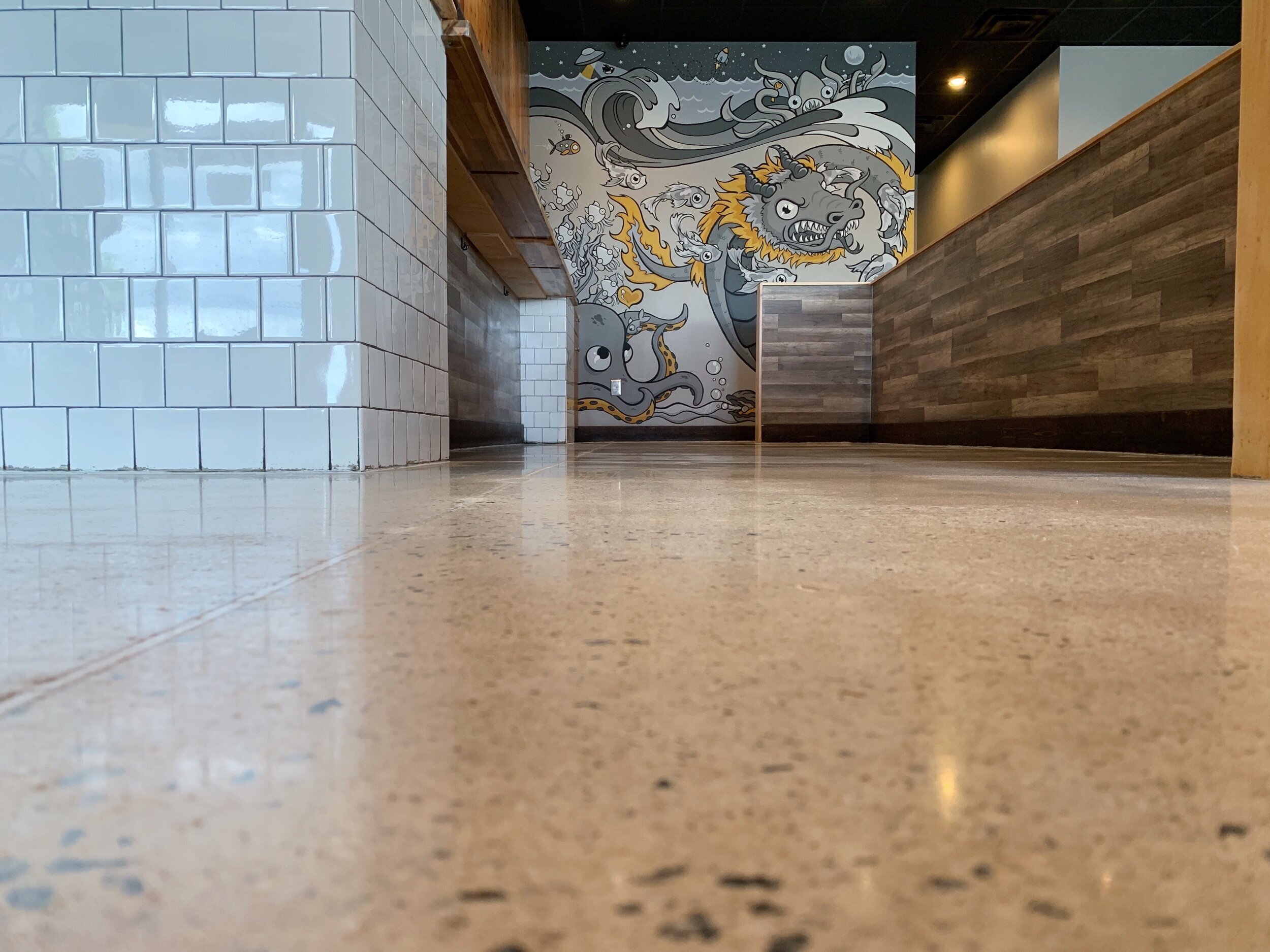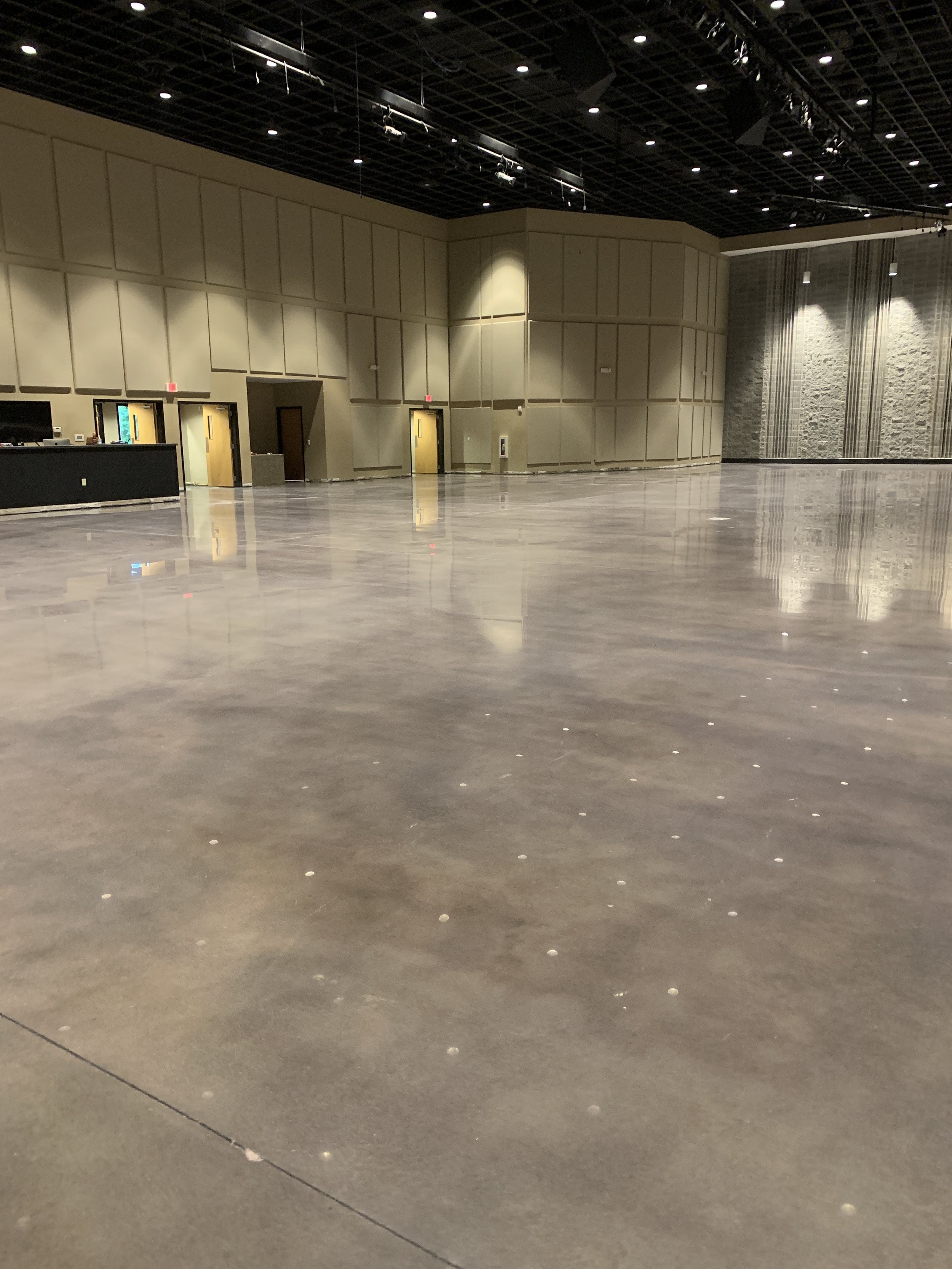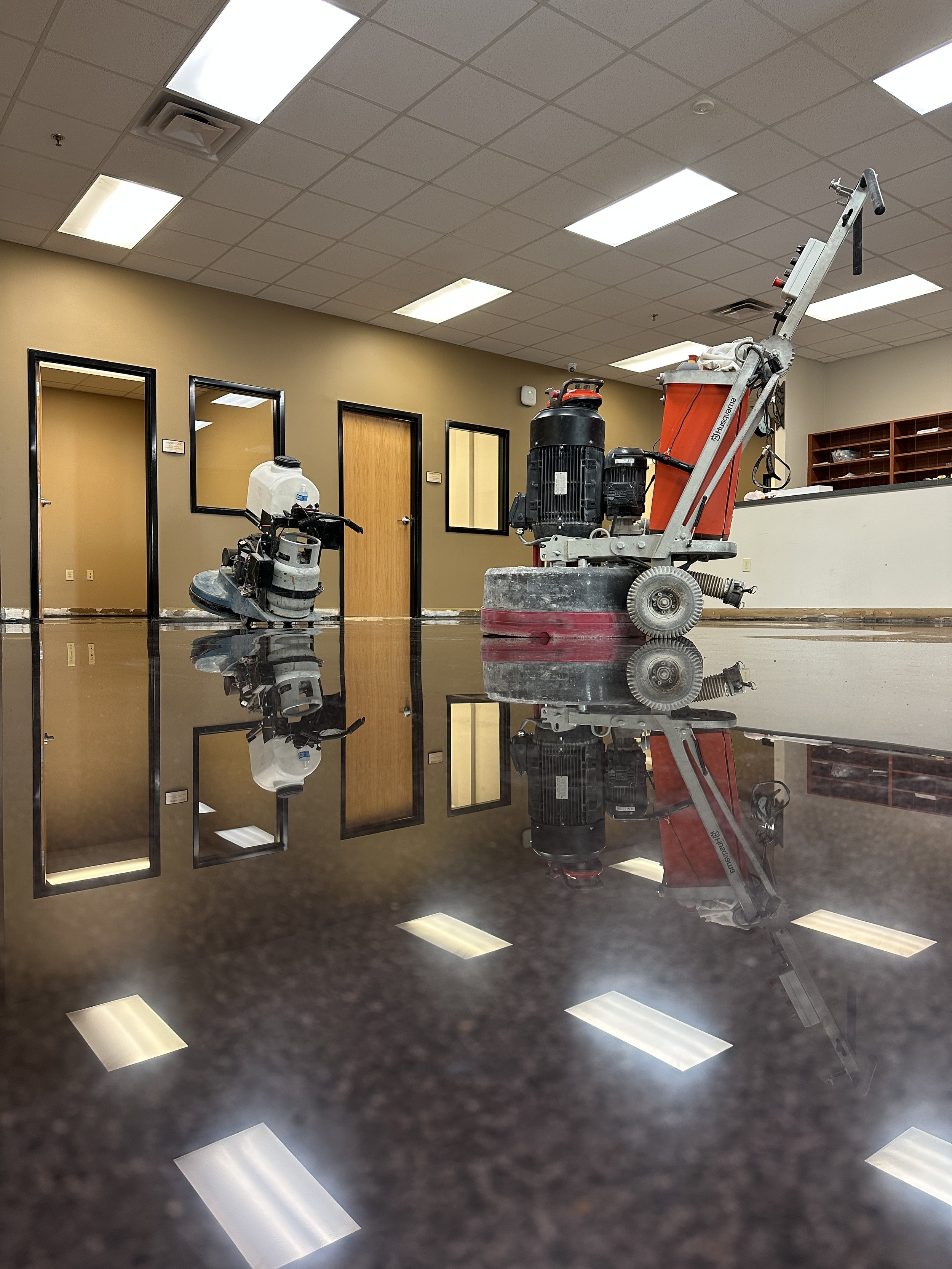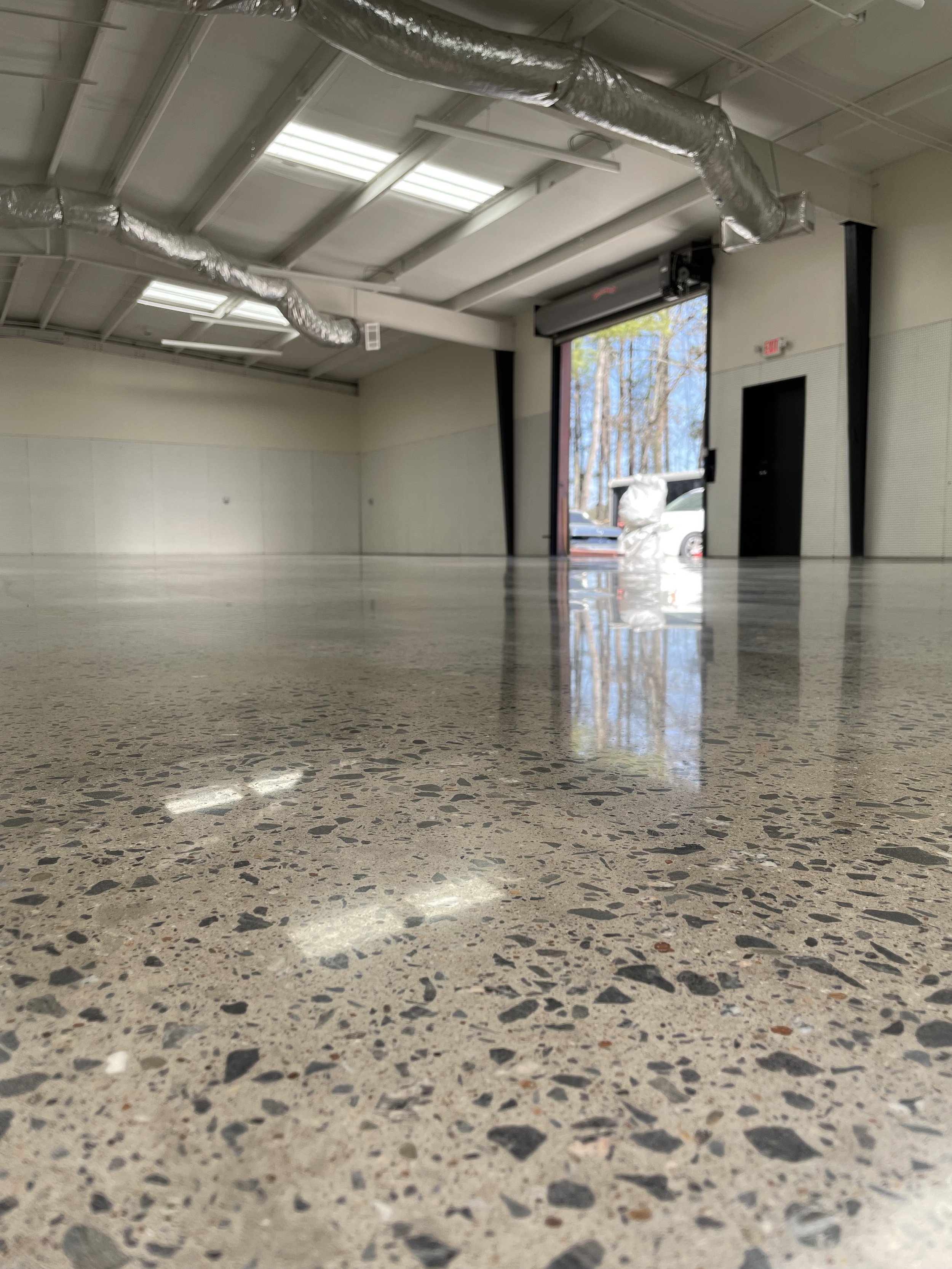What’s the Difference Between Polished Concrete and Grind and Sealed Concrete?
One of the top flooring trends in both commercial and residential spaces is polished concrete floors. Not only are exposed concrete floors aesthetically appealing, but exposed concrete floors are also durable, long-lasting, affordable, environmental friendly, and perfect for many applications - including business, warehouses, retail spaces, homes, restaurants, breweries, art galleries, and so much more. In addition, the desired finish of your refinished exposed concrete can vary from low sheen to high gloss that resembles glass.
If you are interested in exposed concrete flooring for your business or home, you may come across flooring companies that offer both polished concrete and sealed concrete. Clients are left wondering, “Is polished concrete or sealed concrete best for my project and space.. and what’s the difference?”. Both polished concrete and grind and sealed concrete floors are great flooring solutions, and they can look almost identical. Due to their similar appearances, many consumers are not aware of the differences between polished concrete and grind/sealed concrete floors. This can result in confusion when requesting quotes or gathering information for your project.
Polished Concrete & Sealed Concrete Look Similar, But They Are Quite Different
Polished concrete and sealed concrete floors look almost identical. Even some contractors may have trouble first distinguishing between the two systems. However, the shine/finish is achieved by completely different processes. Polished concrete is more labor intensive and involves more steps than grind/sealed concrete floors.
Here’s a quick summary of comparing the two processes: Concrete polishing is the mechanical process of polishing the surface of an existing concrete slab using engineered floor grinders fitted with industrial diamonds. During this process, the concrete is honed and polished using progressively finer grits of diamond abrasives until the floor reaches the desired level of shine (either level 1-4; matte to high gloss). However with sealed concrete, the gloss is achieved from a topical sealer. The process is simpler and involves less grinding, honing, and polishing steps. In terms of durability and benefits, polished concrete has a much longer lifetime expectancy and is much more durable, especially in areas with high traffic. We typically recommend sealed concrete as a more affordable alternative to polished concrete.
Keep reading to learn about the key differences of concrete polishing vs grind and sealed concrete floors, including appearance, durability, and price difference, to help make your decision for your next decorative concrete flooring project.
What Are Polished Concrete Floors?
Polished concrete is the mechanical process of honing and polishing the surface of an existing concrete slab using engineered floor grinders fitted with industrial diamond abrasives. During this process, the concrete is ground, honed, and polished using finer grits of diamond abrasives until the floor reaches the desired level of shine. With polished concrete, there are four levels of finish/shine.
Different LEVELS OF POLISHED CONCRETE
Level 1 - Soft Matte Finish: a Level 1 Polished Concrete floor has a matte finish and will appear soft and hazy with minimal clarity or reflection.
Level 2 - Low Sheen Finish: a Level 2 Polished Concrete floor has a low luster sheen. This is the most popular floor finish for polished concrete. At about a 100 feet distance, you can start to see slight overhead reflection.
Level 3 - Medium Gloss Finish: a Level 3 Polished Concrete floor has a medium gloss finish. This polish produces a gloss on the floor that will clearly reflect objects. This finish is popular in areas where a glossy finish is desired, i.e. restaurants, breweries, retail, etc. There will be good light reflectivity. At about a 30-50 ft distance, the floor will clearly reflect light.
Level 4 - High Gloss Finish: a Level 4 Polished Concrete floor has a high gloss finish. This polish produces the highest level of shine, similar to glass with high light reflectivity. The floor almost appears wet from many vantage points.
What Are Grind and Sealed Concrete Floors?
Grind and sealed concrete is exactly like its name. The process involves grinding your concrete, then sealing with a topical sealer.
Here are the steps for grind and seal concrete:
The process involves grinding the concrete with engineered concrete floor surface grinders to remove any contaminants from the existing slab.
Next, cracks and divots in the floor are patched with patching material as necessary.
Depending on your floor goals (i.e. desired finish and durability requirements), the concrete may be ground again with finer diamonds to further smooth the floor. If the concrete is soft, porous or free of contaminants, a second pass may not be necessary.
Afterwards, the surface is properly cleaned.
If desired, at this step a stain color can be added to your grind and seal concrete project. Choose from a wide variety of colors, from neutral, earth tones to colorful concrete dyes.
Lastly, your sealed concrete floor is sealed with a topical sealer. Depending on your floor goals, requirements, and your space, your concrete flooring company will recommend the best type of sealer for your project. Softer, more porous concrete may require multiple additional coats of sealer. This is common in residential settings.
Now that we’ve defined both polished concrete and sealed concrete floors, let’s breakdown the main factors of their differences, including appearance, durability, lifetime, and cost.
POLISHED CONCRETE VS. GRIND AND SEALED CONCRETE FLOOR
1. Appearance
Sometimes it may be hard to spot the difference between polished concrete and sealed concrete because they can look almost identical. Both polished and grind/seal concrete floors can have a matte, satin, or gloss appearance. However, the finish (either matte, satin, or gloss) is achieved in unique processes. For polished concrete, the concrete is polished using finer grits of diamond abrasives until the floor reaches the desired level of shine (level 1-4). However with sealed concrete, the finish is achieved from a topical sealer.
Another appearance difference is grind/sealed concrete has a more consistent appearance from one concrete floor to the next. The reason is the high-performance sealer is consistent on each application because it is not reliant on the concrete’s profile, unlike polished concrete. This may be beneficial for those looking to match sealed concrete floors throughout their space. With polished concrete, the finished look can vary from concrete to concrete because a different canvas is presented and extraneous factors can affect the final finish, such as the level of hardness or imperfections.
Color stains can be applied to both polished concrete and grind and seal concrete floors. Therefore, both polished concrete and sealed concrete can be referred to as “stained concrete”. Be sure to clarify with your concrete flooring company which system will be used if you are requesting a stained concrete floor.
2. Durability
When choosing between polished concrete and grind/seal concrete, it’s important for your flooring contractor to understand your project’s space and desired level of durability. Is it an area with traffic (i.e. foot traffic, forklift traffic, etc.)? Is the area prone to spills?
Polished concrete offers long-term durability and includes benefits of densifying, hardening, and dust-proofing. This system is recommended in high volume spaces because it has a scratch-resistant finish and requires minimal maintenance. It also lasts for decades when properly maintained. However with sealed concrete and depending on the traffic level, your surface may need to be resealed annually. For larger spaces, this can ultimately be more expensive than polished concrete.
In ares with stains, oils, grease, animal urine etc.:
Grind and seal floors help protect against grease, oil spills, stains, and animal urine. If needed for your space, these sealed concrete floors can utilize chemical-resistant polyurethane sealers, allowing the floor to easily be cleaned away of stains that could typically cause permanent damage to other flooring systems. This is useful in commercial restrooms. For example, if a restaurant is opting for polished concrete throughout the restaurant, it would be recommended to install sealed concrete in the bathrooms. The combination of polished and sealed floors in the restaurant will maintain a cohesive appearance and also deliver the benefits of each system.
3. Cost
Concrete polishing is more labor intensive and costs more than grind/seal or burnished concrete. If interested in polished concrete floor but would like a more affordable option, we recommend to choose from either grind and seal concrete or burnished polished concrete.
Sealed Concrete vs Polished Concrete
Sealed concrete floors and polished concrete floors are two different types of concrete finishes, each with its own unique characteristics and benefits.
Sealed concrete floors involve the application of a protective sealer to the surface of the concrete. The sealer penetrates the surface of the concrete and creates a barrier that helps to prevent moisture and stains from penetrating the surface. Sealed concrete floors can have a matte or gloss finish, depending on the type of sealer used, and can be tinted to achieve a variety of colors. Sealed concrete floors are typically less expensive than polished concrete floors and are a popular choice for industrial and commercial settings.
Polished concrete floors involve the use of specialized machinery, such as diamond grinders and polishers, to grind and polish the surface of the concrete to achieve a smooth, high-gloss finish. The polishing process involves multiple steps and typically involves the use of progressively finer grits of diamond abrasives to achieve the desired finish. Polished concrete floors are durable, long-lasting, and have a high-end, elegant look that is popular in residential, commercial, and retail settings. Polished concrete floors are typically more expensive than sealed concrete floors due to the specialized equipment and labor required for the polishing process.
In summary, sealed concrete floors provide a protective barrier to the surface of the concrete, while polished concrete floors involve a multi-step process to grind and polish the surface to achieve a smooth, high-gloss finish. The choice of finish depends on the specific needs and aesthetic preferences of the project, as well as the budget available.
Alternatives to Polished Concrete
Benefits of Burnished Concrete
Burnished polished concrete resembles polished concrete but does not require as many steps. This system is less labor intensive which makes it more affordable. The burnished concrete process involves utilizing a high-speed burnisher that spins at approximately 1,500 rpm to 2,500 rpm to fils the concrete’s pores with an applied chemical. The burnishing machinery heats and buffs the topical coating into a concrete surface. It’s important to note the finished floor is less durable than polished concrete and does require more maintenance.
If you are in the Southeast area and are interested in a quote for polished concrete, grind and seal concrete, or burnished concrete floors, request a quote online here.






